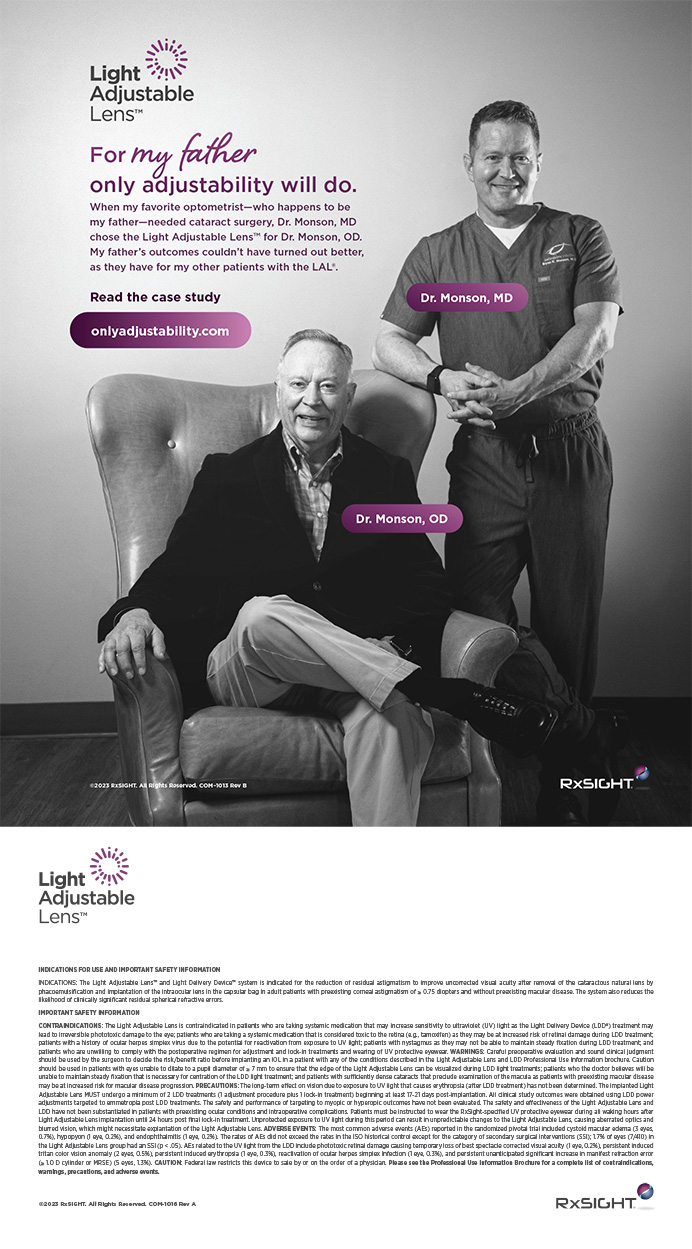After cataract surgery, stromal hydration is the most common method of “sealing” clear corneal incisions. It is not a perfect solution to wound closure, however, because the effects are transient and inconsistent with respect to endurance. After cataract surgery, wounds are likely to leak with little to no provocation. In a clinical study, 48.8% of eyes experienced spontaneous leakage, and incisions in 97.6% of eyes leaked with the application of 1 ounce of pressure or less to the ocular surface.1 Although hydration increases the IOP to close the wound internally, it does not provide a physical barrier that protects against fluid egress and ingress, which has the potential to introduce harmful bacteria into the wound once the IOP drops some hours later.
NOT MANY OPTIONS
To date, the gold standard for sealing incisions has been suturing, although sealants like cyanoacrylates and fibrin glues have generated some interest. All of these options, however, expose the patient to potential complications and discomfort. Sutures sometimes induce astigmatism, and their removal requires a separate procedure. Furthermore, patients may worry about the quality of their surgery when a suture is used—something their peers undergoing cataract surgery probably did not require.
Cyanoacrylates and fibrin glues have been used off label for wound closure, because they provide a physical barrier. These two options have a number of serious drawbacks. It is well known that cyanoacrylates are extremely uncomfortable for patients, because they cause foreign body sensation. Fibrin glues are not an option for many patients and practices due to their high cost and the preparation required. In addition to its leak-preventing superiority, a hydrogel sealant offers some advantages for patients and surgeons.
FIRST SEALANT APPROVED
ReSure Sealant (Ocular Therapeutix) is the first FDA- approved sealant for wound closure. It is composed of polyethylene glycol, a large biocompatible molecule frequently used in eye drops. ReSure begins as a liquid and forms a soft hydrogel, adherent as it polymerizes. In the phase 3 FDA trial of this device, the sealant demonstrated superiority to sutures for preventing wound leakage. Of eyes in the sealant group, 4.1% leaked after provocation with 1 ounce of pressure compared with 34.1% in the suture group.1 Additionally, the sealant better prevented device-related adverse ocular events than sutures (1.6% in the sealant group vs 30.6% in the suture group).
To prepare and apply the sealant takes about 30 seconds. The product contains a blue colorant that aids in visualization during application and fades away in about 1 hour. Because the sealant is then clear and flexible, it is also comfortable for the patient. In 94.1% of cases in the trial, the surgeon rated the sealant as “easy” or “very easy” to use. The product sloughs off in the tears during re- epithelialization in the first week after surgery, so there is no need for removal.
FLUID EGRESS HAPPENS
Even well-constructed, clear corneal and femtosecond laser-created incisions are prone to fluid egress when external pressure it applied, as happens during manipulation by the patient or the instillation of eye drops, for example. When the wound’s integrity is questionable, and it may be vulnerable to leakage, the application of a hydrogel sealant can provide security. For example, enlarged incisions and phaco burns can compromise wound integrity, as can increased manipulation in eyes with dense cataracts, intra- operative floppy iris syndrome, or additional procedures such as the use of a trabecular microbypass stent. In these situations, surgeons may wish to consider closing the incision with a hydrogel sealant.
The hydrogel can increase safety in cases of perfectly constructed wounds and also provide added security for patients with a medical history of concern. For example, patients who have had previous ocular surgery are at increased risk of developing complications. Similarly, those with diabetes or compromised immune systems who heal at a much slower rate could benefit from the sealant. The additional security would also help monocular patients, who must avoid adverse events.
CONCLUSION
The cost of the ReSure Sealant may limit its initial use. The benefits it can provide, however, should earn the device a place in every surgeon’s toolkit. The reduced rate of adverse events and enhanced wound closure compared with the preexisting options may well outweigh the sealant’s cost for select cataract cases.
John A. Hovanesian, MD, is in private practice at Harvard Eye Associates in Laguna Beach, California, and is a clinical instructor at the Jules Stein Eye Institute, University of California, Los Angeles. He is a consultant to Ocular Therapeutix and is an equity holder in the company. Dr. Hovanesian may be reached at (949) 951-2020; drhovanesian@harvardeye.com.
- Guttman Krader C, Kim T. Study: hydrogel sealant better than sutures. Ophthalmology Times. January 1, 2014. http://ophthalmologytimes.modernmedicine.com/ophthalmologytimes/news/study-hydrogel- sealant-better-sutures?page=full. Accessed July 10, 2014.


